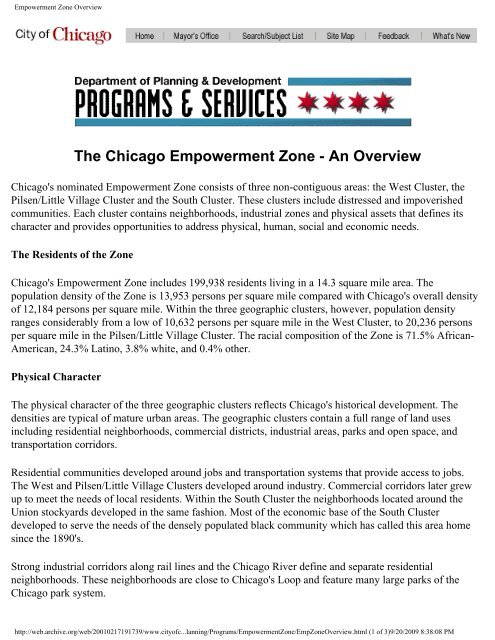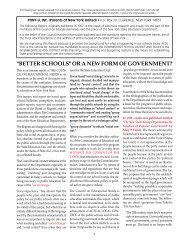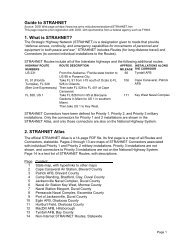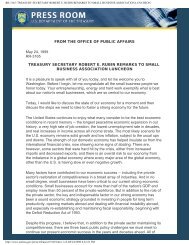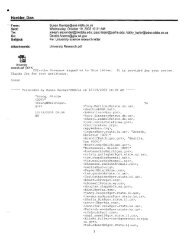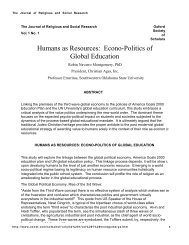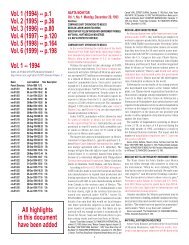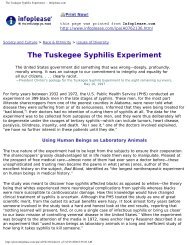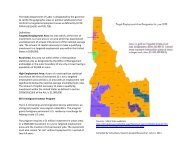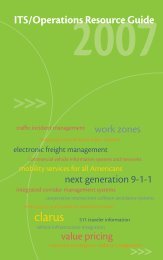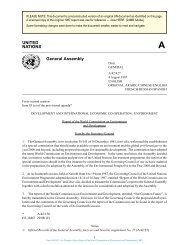<strong>Empowerment</strong> <strong>Zone</strong> OverviewThe Chicago <strong>Empowerment</strong> <strong>Zone</strong> - An OverviewChicago's nominated <strong>Empowerment</strong> <strong>Zone</strong> consists of three non-contiguous areas: the West Cluster, thePilsen/Little Village Cluster and the South Cluster. These clusters include distressed and impoverishedcommunities. Each cluster contains neighborhoods, industrial zones and physical assets that defines itscharacter and provides opportunities to address physical, human, social and economic needs.The Residents of the <strong>Zone</strong>Chicago's <strong>Empowerment</strong> <strong>Zone</strong> includes 199,938 residents living in a 14.3 square mile area. Thepopulation density of the <strong>Zone</strong> is 13,953 persons per square mile compared with Chicago's overall densityof 12,184 persons per square mile. Within the three geographic clusters, however, population densityranges considerably from a low of 10,632 persons per square mile in the West Cluster, to 20,236 personsper square mile in the Pilsen/Little Village Cluster. The racial composition of the <strong>Zone</strong> is 71.5% African-American, 24.3% Latino, 3.8% white, and 0.4% other.Physical CharacterThe physical character of the three geographic clusters reflects Chicago's historical development. Thedensities are typical of mature urban areas. The geographic clusters contain a full range of land usesincluding residential neighborhoods, commercial districts, industrial areas, parks and open space, andtransportation corridors.Residential communities developed around jobs and transportation systems that provide access to jobs.The West and Pilsen/Little Village Clusters developed around industry. Commercial corridors later grewup to meet the needs of local residents. Within the South Cluster the neighborhoods located around theUnion stockyards developed in the same fashion. Most of the economic base of the South Clusterdeveloped to serve the needs of the densely populated black community which has called this area homesince the 1890's.Strong industrial corridors along rail lines and the Chicago River define and separate residentialneighborhoods. These neighborhoods are close to Chicago's Loop and feature many large parks of theChicago park system.http://web.archive.org/web/20010217191739/www.cityofc...lanning/<strong>Program</strong>s/<strong>Empowerment</strong><strong>Zone</strong>/Emp<strong>Zone</strong>Overview.html (1 of 3)9/20/2009 8:38:08 PM
<strong>Empowerment</strong> <strong>Zone</strong> Overview<strong>Zone</strong> AssetsAlthough the <strong>Empowerment</strong> <strong>Zone</strong> communities have lost much of their historic strength over the last fewdecades, they still possess strong assets on which to build a bright future. These assets include atransportation network that is unparalleled in the nation, first-rate hospitals, colleges and universities,sports and cultural facilities that attract hundreds of thousands each year, park and recreational facilities,abundant industrially and commercially zoned land upon which to build economic strength, andcommitted residents and community-based organizations with historic involvement in their communities.The <strong>Empowerment</strong> <strong>Zone</strong> communities are served by three major expressways: the Dan Ryan, theStevenson and the Eisenhower linking the <strong>Zone</strong> with the rest of the metropolitan area. The ChicagoTransit Authority (CTA)'s rapid transit lines date from the 1890's and link the <strong>Zone</strong> to the rest of Chicagoand adjacent suburbs. Metra commuter rail lines provide additional transit links to Chicago's Loop,suburban communities and the rest of the nation. The $300 million renovation of the CTA's "Green Line",completed in 1995, represents a strong local commitment to maintaining transit access for even Chicago'smost impoverished neighborhoods.The University of Chicago, the Illinois Institute of Technology, Northeastern Illinois University's Centerfor Inner-City Studies and The University of Illinois at Chicago are all located near the <strong>Empowerment</strong><strong>Zone</strong> communities. These institutions have traditionally provided technical assistance and support to manycommunity groups active in <strong>Empowerment</strong> <strong>Zone</strong> neighborhoods. Two of Chicago's City Colleges----Malcolm X and Kennedy-King----provide vocational training and education for area residents.The hospitals and medical schools in an around the <strong>Empowerment</strong> <strong>Zone</strong> are strong resource anchors.More than a dozen hospitals range from facilities that primarily serve the needs of neighborhood residentsto world class teaching hospitals, and include: Michael Reese/Humana, Sacred Heart, NorwegianAmerican, St. Elizabeth's, St. Mary of Nazareth, Loreto, Bethany, the Westside VA, Cook County, RushPresbyterian-St. Luke's Medical Center, St. Cabrini, the University of Illinois, Mt. Sinai, St. Anthony,Provident, and La Rabida Children's Hospital. These facilities are most strongly concentrated in andaround the West Cluster.The Museum of Science and Industry, the DuSable Museum, the Mexican Fine Arts Museum and theGarfield Park Conservatory are cultural assets that draw visitors from other parts of the Chicago region.Among the key trademarks of Chicago are its boulevards, its lakefront park system and its largecommunity parks, a legacy left by planning giants like Daniel Burnham. These open space resources arephysical amenities that can be enhanced to help rebuild attractive and desirable residential neighborhoods.The Chicago Park District is in the process of reassessing its service delivery and working to meet theneeds of the community. It has an established capital improvement program designed to upgrade parksand recreational facilities. Garfield Park, the Garfield Park Garden for the Blind, and the Garfield ParkConservatory are located in the West Cluster. The Garfield Park Conservatory is the world's largestenclosed conservatory, covering 4.5 acres with over 5,000 varieties of plants, flowers and trees. BurnhamPark forms an eastern edge of the South Cluster and is an important link in Chicago's lakefront parkhttp://web.archive.org/web/20010217191739/www.cityofc...lanning/<strong>Program</strong>s/<strong>Empowerment</strong><strong>Zone</strong>/Emp<strong>Zone</strong>Overview.html (2 of 3)9/20/2009 8:38:08 PM


